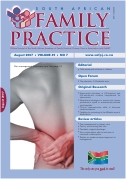Nosocomial infections in HIV-infected and HIV-uninfected children hospitalized for tuberculosis
Keywords:
nosocomial infections, HIV infection, children, tuberculosis, varicella, pneumonia, antiretroviral treatment
Abstract
Background The interaction between tuberculosis and human immunodeficiency virus (HIV) infection is well known and is responsible for the increase in the incidence of tuberculosis (TB) in sub-Saharan Africa over the last decade. This places a considerable extra burden on health services. The Brooklyn Hospital for Chest Diseases (BCH) is a non-acute TB hospital for the City of Cape Town, South Africa. The hospital has 60 children’s beds and approximately 140 paediatric admissions annually. This study, undertaken before the availability of antiretroviral drugs in the public sector in South Africa, documents the occurrence of nosocomial infections in HIV-infected and HIV-uninfected children at BCH. Methods This retrospective case-control study evaluated the occurrence of nosocomial infections in human immunodeficiency virus (HIV)-infected children and age- and time of admission-matched HIV-uninfected children admitted to the BCH, Cape Town, South Africa between July 1999 and December 2001 for the treatment of tuberculosis (TB). Results Forty-seven HIV-infected children (mean age 40 months) and 47 HIV-uninfected children (mean age 41 months) were studied. The HIV-infected children, who were not receiving antiretroviral therapy because it was not yet available in the public sector, experienced 109 episodes of nosocomial infections compared to 22 episodes amongst those not infected with HIV (p = 0.001). Twenty-five nosocomial infections (23%) among the HIV-infected children, but only two (9%) among the HIV-uninfected children, were serious enough to require transfer to a tertiary care hospital for management. Pneumonia was the commonest nosocomial infection and occurred in 26 (56%) HIV-infected patients, of whom three died, but in only four (9%) HIV-uninfected children, none of whom died. An outbreak of varicella affected 10 HIV-infected (21%) and 9 HIV-uninfected children (19%). One HIV-infected child died of varicella pneumonia. Other common nosocomial infections encountered in HIV-infected and HIV-uninfected children respectively were upper respiratory tract infections (pharyngitis, tonsillitis or rhinitis) affecting 21 and four, otitis media in five and one, oral candidiasis in seven and 0, urinary tract infection in four and one and acute gastroenteritis in five and zero children. Five HIV-infected children (11%) died and four of the deaths were known to be due to nosocomial infection; only one HIV-uninfected child died from severe miliary TB. Conclusions Nosocomial infections occurring in HIV-infected children are a serious cause of morbidity and mortality in children hospitalised for the treatment of tuberculosis. Their impact could be reduced by the earlier introduction of antiretroviral treatment and by immunisation against certain of the infecting agents. Post-exposure prophylaxis for varicella could prevent or alleviate disease.
Published
2007-08-02
Section
Original Research
By submitting manuscripts to SAFP, authors of original articles are assigning copyright to the South African Academy of Family Physicians. Copyright of review articles are assigned to the Publisher, Medpharm Publications (Pty) Ltd, unless otherwise specified. Authors may use their own work after publication without written permission, provided they acknowledge the original source. Individuals and academic institutions may freely copy and distribute articles published in SAFP for educational and research purposes without obtaining permission.

